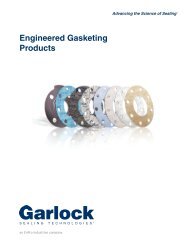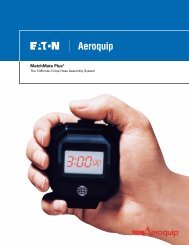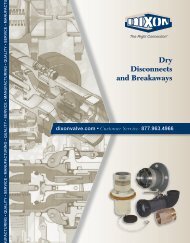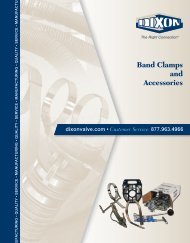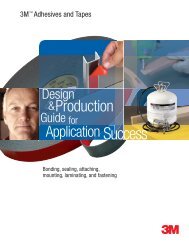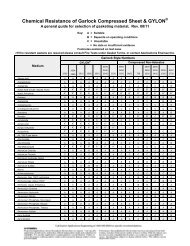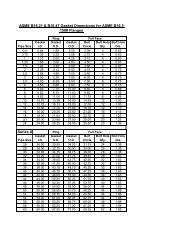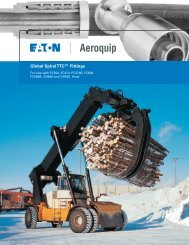Compression Packing Technical Manual - RevBase
Compression Packing Technical Manual - RevBase
Compression Packing Technical Manual - RevBase
You also want an ePaper? Increase the reach of your titles
YUMPU automatically turns print PDFs into web optimized ePapers that Google loves.
Pump <strong>Packing</strong><br />
1. Remove all the old packing with packing hooks, being<br />
careful not to damage the shaft or sleeve. This means<br />
all rings, even the lantern ring and the rings below the<br />
lantern. Clean the stuffing box and examine the shaft<br />
and sleeve. Replace any worn parts that are scored<br />
or deeply grooved.<br />
2. Measure and record shaft diameter, stuffing box bore<br />
and box depth. To determine the correct packing size,<br />
measure the diameter of the shaft and the stuffing<br />
box bore. Subtract the shaft diameter from the bore<br />
diameter and divide the difference by two. This is the<br />
required cross-sectional size.<br />
Step 1 Step 2<br />
I.D.<br />
O.D.<br />
3. Always cut the packing into individual rings. Never wind<br />
the packing into a coil in the stuffing box. Rings should<br />
be cut with a butt joint. Cut rings by using a mandrel<br />
with the same diameter as the shaft in the stuffing box<br />
area. If there is no wear, rings can be cut on the shaft<br />
outside the stuffing box.<br />
Hold the packing tightly on the mandrel, but do not<br />
stretch excessively. Cut the ring and insert it into the<br />
stuffing box, making certain that it fits the packing<br />
space properly. Each additional ring can be cut in the<br />
same manner.<br />
Step 3<br />
Butt Cut<br />
Joints<br />
Mandrel<br />
Ruler<br />
Do Not<br />
Stretch<br />
<strong>Packing</strong><br />
4. Install one ring at a time. Make sure it is clean, and has<br />
not picked up any dirt in handling. Lubricate the I.D.<br />
of each ring lightly. Start one end and then the other,<br />
butted closely. Work around circumference from either<br />
or both directions. Joints of successive rings should be<br />
staggered and kept at least 90° apart. Each individual<br />
ring should be firmly seated with a tamping tool. When<br />
enough rings have been individually seated so that the<br />
nose of the gland follower will reach them, individual<br />
tamping should be supplemented by the gland.<br />
Steps 5 and 6<br />
Gland<br />
Follower<br />
Lantern<br />
Ring<br />
Flush<br />
Port<br />
Braided<br />
<strong>Packing</strong><br />
5. If a lantern ring is provided, make sure the lantern ring<br />
is installed under the pipe tap hole.<br />
6. After the last ring is installed, bring the follower down<br />
on the packing and finger-tighten the gland nuts. Do<br />
not jam the packing by excessive gland loading. Start<br />
pump, and tighten the bolts until leakage is decreased<br />
to a tolerable minimum. Make sure gland bolts are<br />
tightened evenly. Stopping leakage entirely at this<br />
point will cause the packing to burn up.<br />
7. Allow packing to leak freely upon startup after repack.<br />
Gradually reducing leakage during the first hour of<br />
operation will result in a better seal over a longer period<br />
of time. Tighten the gland nuts one flat at a time<br />
until the desired leakage is obtained, and the pump is<br />
running cool.<br />
A-26






